DISCLAIMER: As an Amazon associate i earn from qualifying purchases. This post contains affiliate links which will reward me monetarily (or otherwise) when used to make qualifying purchases. for more info, please see my disclosure policy.
Did you just finish Marie-Kondoing your closet? Maybe you’ve been spring cleaning your entire house & have a huge pile of clothing (from your kiddos baby outfits to that dress you’ve had forEVER) that you don’t know what to do with?
Good news: you can take that stuff and resell it online. That’s right! You can sell used clothing from the comfort of your home to make a little extra cash. Doesn’t that sound FUN?!
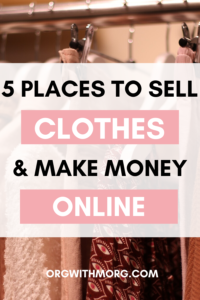
If you’re sold on the idea of selling, but your biggest question is WHERE?, I’ve got you covered. With everything from online consignment to resell apps, it can be hard to know where to sell your clothing…and where you’ll get the best bang for your buck.
Since reselling clothing is my full-time job, I’m always on the hunt for the best apps to sell clothes. I’ve gathered up 4 resell apps (and one local option) to help you decide the perfect place for you. Let’s get started!
Selling Platforms
While there are a variety of platforms/places to sell used clothing on, here are a few of my favorites:
1. Poshmark
According to their website, Poshmark is a “social commerce marketplace where people can buy and sell new or used clothing, shoes, and accessories.”
Poshmark is for users in the United States and Canada only, and is primarily known as a new and secondhand fashion marketplace.
THE PROCESS
I discuss how to sell on Poshmark more in-depth on my post here, but here’s the basics:
- Take photographs of your items in a well-lit space. Make sure they are square or that you crop them, as the platform only allows square photos.
- Add details requested, including a description, shown in the photos below. Not all details are required, but try to be as detailed as possible.
- Choose your listing price. If you’re unsure of what your listing is selling for, I have a completely free guide that shows you how to check comparable sold items step-by-step.
- LIST! Once everything’s filled in, make your item live! If you want your item to show up at the top of search results, be sure to share it daily.
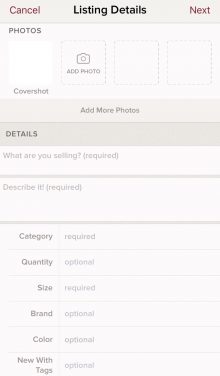
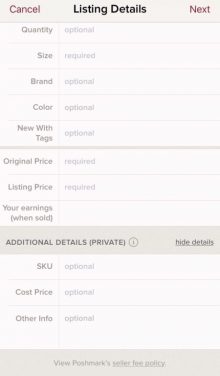
FEES
For sales above $15, Poshmark will take 20%. For sales under $15, it’s a flat fee of $2.95. If you provide shipping discounts ($2.11 or $7.11) those come out of your earnings as well.
PROHIBITED ITEMS
While Poshmark is known as a clothing app, they also allow some homegoods. Please click here if you’d like a list of accepted items in the home category.
Poshmark does not allow the selling of electronics, furniture, health and wellness products, select beauty products (such as perfume or nail polish) or non-clothing baby items. Here’s the full prohibited items policy.
SHIPPING
One of my favorite things about Poshmark is their shipping. When you sell an item, Poshmark automatically sends you a prepaid, pre-addressed shipping label.
All sales ship using USPS Priority mail, and can be sent in free boxes (excluding express) provided by USPS. Labels cover up to 5 lb. shipping.
Shipping is $7.11 for everything, paid by the buyer, unless you offer a shipping discount.
THE GOOD & BAD
THE POSITIVE: Shipping is incredibly easy on this platform. Just pick up a free box from USPS (except Express), slap on a prepaid shipping label, and schedule a pickup or take it to your local post office!
THE NEGATIVE: Poshmark is known as a “social app,” which means you’ll have to share your listings to move them to the top of search results. If you’re looking for a platform where you can just list it & forget it, you may not get the results you’re looking for here.
SIGNING UP
Want to create a Poshmark account? Click here & enter my referral/invite code ORGWITHMORG to receive $10 off your first purchase!
2. thredUP
According to their website, thredUP is “the world’s largest online thrift store where you can buy and sell high-
thredUP runs on a consignment model, which is different from the other platforms mentioned here. You send them your inventory, which they list on their website for a period of 60-90 days. If your item sells, you get a set percentage from that sale, based on the price of the item.
THE PROCESS
Since thredUP is consignment based, you send your items directly to them. They do all of the work- including shipping, inspecting, AND photographing.
To send items to thredUP, you must request a clean out kit. You can either sell your clothing or donate it to them and receive a tax receipt. Upon ordering your kit, you will need to choose your processing method (free or expedited) and whether you would like any items not accepted to by recycled or sent back to you for a fee.
For your kit, you can request that they send you a bag with a pre-paid shipping label OR you can simply print out a label at home and use a box you have on hand.
For higher-end brands, you can request an invitation to thredUP LUXE, which increases your payout on qualifying items to 80%.
FEES
thredUP gives you a percentage of the sale based on your selling price. So, lower value items get a lower payout, and higher-end items get a higher payout.
Payouts can range anywhere from 5% to 80% of the selling price. Here are thredUP’s current payout percentages:
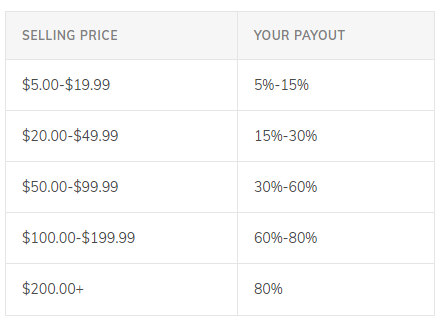
PROHIBITED ITEMS
thredUP only sells women’s and children’s clothing, so men’s clothing, as well as jewelry, are not accepted by thredUP. They also won’t accept clothing that is 10 years or older- so no vintage.
SHIPPING
Besides sending in your prepaid clean out kit, there is no shipping on your end. thredUP ships out ALL of your sales, and handles any returns.
THE GOOD & BAD
THE POSITIVE: Selling items through this platform requires very little work on your end. Simply put your items into their bag or your box, ship ’em using a prepaid label, and get paid!
THE NEGATIVE: There can be a lot of waiting involved with this platform (waiting for kits to become available, waiting for them to process your items, etc.) so if you’re into extremely fast flips (or making a lot of money) then this may not be for your platform of choice.
SIGNING UP
New to thredUP? Sign up using my link to get $10 off your first purchase!
3. Buy Sell Trade Stores
BST stores are in-person locations where individuals sell their items to the store outright.
Commonly known Buy Sell Trade stores are Crossroads, Plato’s Closet, and Style Encore. Options in your area may vary, so be sure to do your research!
THE PROCESS
Unlike consignment stores where you wait for the item to sell to get paid, Buy Sell Trade stores pay you outright.
Simply gather the items you’d like to sell (looking at the specific store’s website/social media will help you see what styles they’re looking for) and head to the store.
Most stores run on walk-ins, so you don’t have to make an appointment beforehand. Employees will sort through your inventory, and when they’re finished, let you know what items they’d like to take and what they’re willing to pay you for them.
Most stores will give you a cash or credit option. If you’re going to buy items in the store, going the credit route may be worth it as those payouts are usually higher.
FEES
There are no “extra” fees- what they say they are going to pay you is what you get!
PROHIBITED ITEMS
Check your local store for details, as most of them will have a “selling guide” that outlines what items they’re currently accepting. Stores may accept items based on season or be in search of certain brands.
SHIPPING
No shipping for this option- everything’s done in person!
THE GOOD & BAD
THE POSITIVE: This method is the best way to sell a lot of inventory FAST. You’ll get your money the same day, so if you’re looking for a quick flip, this option may be for you!
THE NEGATIVE: Payouts at BST stores aren’t the greatest. Some items you may get for a couple dollars for, so be sure to keep that in mind (and do your research) when selling this way.
4. eBay
eBay is an online marketplace, similar to many other shopping sites. However, eBay operates in multiple countries and offers a variety of shipping/selling options.
THE PROCESS
The listing process on eBay is similar to that of Poshmark, although there are a few extra things to consider when selling:
- LISTING FORMAT: Instead of one buying option, eBay offers multiple. There’s the regular “fixed price” option, where people purchase your item at asking price, or “fixed price” with offers, so customers can negotiate with you. eBay also offers an “auction format,” where you set a starting price for your item, as well as an end date, and buyers bid on the item in rising increments.
- DETAILS: eBay offers many more description fields than other platforms. You can add the fabric content, manufacturer location, sleeve style, etc.
FEES
This platform includes insertion fees, final value fees and payment processing fees.
Insertion fees are an amount you pay to list the item. Sellers without a store subscription (see more on that here) have 50 free listings every month. If you list more than 50 items, you’ll pay a fee depending on the specific item category and price. Most likely the insertion fee will be 35 cents.
Final value fees are the amount you pay on a item once it sells. These fees are calculated based on the total amount of the sale, including any shipping fees paid by the buyer. Again, fees vary by category, but on average it’s 10%.
Payment processing fees are, usually, payments processed by Paypal for each transaction. Their fees are 2.9% plus 30 cents per transaction.
To read more about eBay seller fees, go here!
PROHIBITED ITEMS
eBay allows a LOT on the site. Some of their most popular categories are clothing, electronics, collectibles, health & beauty, and homegoods. To see what’s not allowed, read their restricted items policy.
SHIPPING
How you ship on eBay is really up to you- which can be amazing or a little bit scary.
I always recommend having a scale (such as the one below!) to weigh your items so you can find the cheapest, most accurate shipping options.
eBay offers a large variety of shipping options, including:
- economy services, such as USPS Ground & FedEx SmartPost
- standard services, like UPS Ground, FedEx Ground, or USPS First Class
- expedited services, such as USPS Priority & Flat Rate
- one day shipping
- international shipping
If you have the weight of your item and choose calculated shipping, the shipping cost will automatically adjust based on the buyer’s location. You can also offer free shipping, or flat shipping, which is the same cost to all buyers.
Read more on their shipping options here.
THE GOOD & BAD
THE POSITIVE: eBay has lower fees than other online selling platforms (13ish percent with Paypal fees versus Poshmark’s 20%) and makes shipping lighter items a breeze. It’s also great for auctioning off stale inventory, or listing categories besides clothing.
THE NEGATIVE: A lot of success with eBay comes from trial and error, at least in my experience, so if you want a more straightforward solution, you and eBay might not be BFFs anytime soon.
5. Facebook Marketplace
Exactly what it sounds like- a way to buy and sell things locally through Facebook!
THE PROCESS
Selling on this platform is very straightforward- simply open up Facebook (through the app or your browser), create a listing, and you’re good to go!
Marketplace listings are public and can be seen on your News Feed, just so ya know. Here’s what it looks like when you go to create a listing:
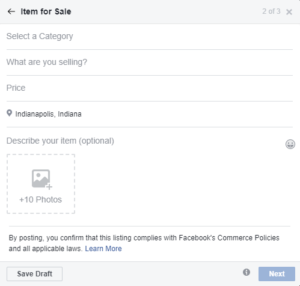
FEES
Nada. Facebook doesn’t take a cut of anything.
SHIPPING
You can ship items, but the beauty is that you don’t have to! Simply figure out your payment method, and when/where to meet with your buyer.
PROHIBITED ITEMS
Like eBay, Facebook allows a large range of goods to be sold. And, since you don’t have to worry about shipping, the weight and size of the item doesn’t really matter- you can sell anything from your TV to car to real estate.
THE GOOD & BAD
THE POSITIVE: Great for selling large, heavier-weight items, or moving inventory quickly. Selling on this platform is also extremely convenient since there’s no extra app or account necessary- everything’s done through Facebook.
THE NEGATIVE: There’s no seller or buyer protection, meaning that sales on here can have a bit of a higher risk (people may set up a meeting time but never show, etc.). Since your buyer pool is based on your physical location, you also aren’t reaching as many potential customers as you could be on other platforms.
Recap
As a recap, here are the what I believe to be the pros & cons of each platform:
- POSHMARK: easy shipping for under 5 pounds/NOT a “list it and forget it” platform
- THREDUP: most of the work done for you/involves a lot of waiting
- BUY SELL TRADE STORES: can sell clothing fast/small payouts
- EBAY: ability to list in multiple categories/more complicated listing and shipping options
- FACEBOOK MARKETPLACE: extremely convenient/no seller or buyer protection
There’s no right or wrong answer to which selling platform is superior to sell used clothing…especially since I only discussed a handful of options, and there are many, many out there.
I hope this was helpful for you! Leave a comment down below if there are any places to sell clothes you’d like covered or topics you’d like discussed. And, if you’re going to try one of these platforms yourself, let me know!
Cheers to spring cleaning & making money from your the comfort of your couch!


As a brand newbie, I really appreciate that you have a great go to site with lots of information. I just recently went spring shoe crazy and ordered a bunch of shoes from Poshmark…and have been trying to come up with a way to replace my part time income so I can leave that job…and voila…why not try reselling? I only need to replace $600 net/month. Thank you for using your knowledge to give back and I’m looking forward to scouring your site and blog and resources to learn lots.